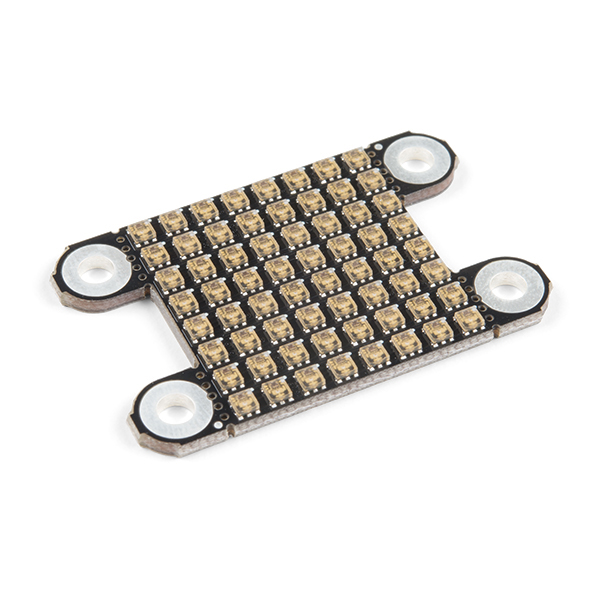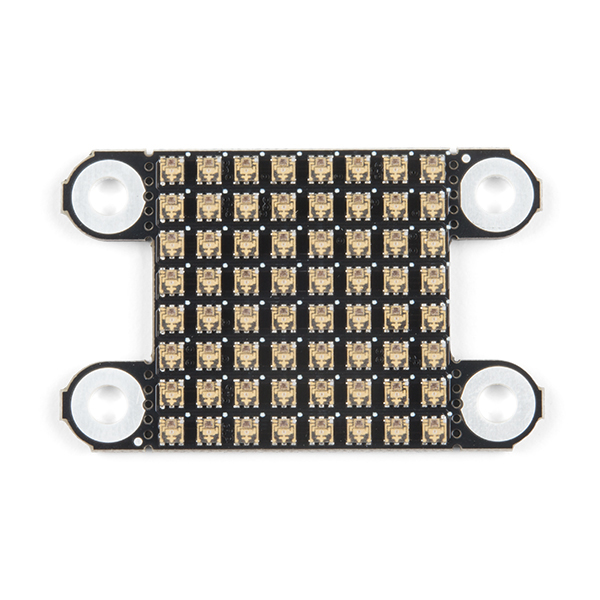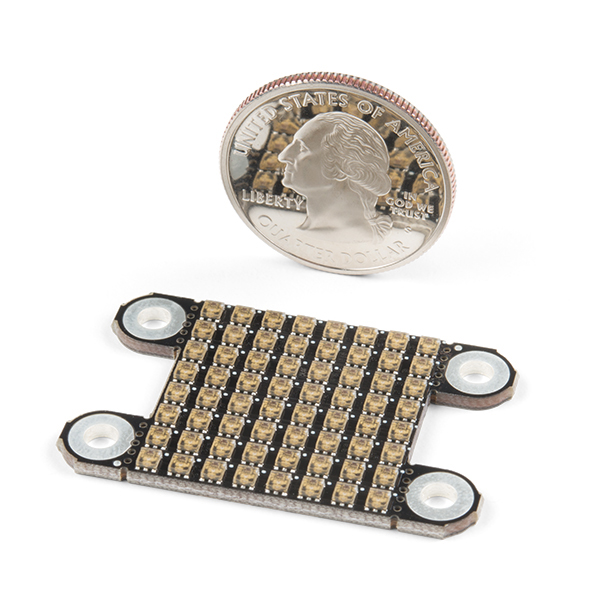SparkFun LuMini LED Matrix - 8x8 (64 x APA102-2020)
This is the 8x8 SparkFun LuMini LED Matrix, packed with 64 individually addressable LEDs, each capable of producing 16 million colors, it provides you with a great way to add a square of light to just about anything, or even make a screen of a custom shape! LuMini is a miniaturized version of our Lumenati LED line but instead of utilizing 5mm by 5mm APA102 LEDs (APA102-5050), LuMini uses a 2mm by 2mm package (APA102-2020). This allows for incredibly tight pixel densities, and thus, a screen with less pixelation!
The LuMini LED Matrix is powered and controlled using a few solder pads on the back of each board. These pads include 5V and ground, a set of pads for data in and clock input, and another set for data out and clock output. Since the matrix acts like a string of LEDs, the indexing (or numbering) of the LEDs moves from left to right, bottom to top of the board, on the LED facing side. The last handy feature we've equipped the LuMini LED Matrix with is four detachable mounting points that can be used to secure your ring to a surface/project or be broken off to make more complex designs. However if you want to break off the mounting holes from the board, multiple matrices can be soldered together to form a larger display!
Note: In larger installations you may need to add a decoupling capacitor between power and ground to prevent voltage dips when turning on a whole bunch of LED’s simultaneously. We recommend using a 4.7µF capacitor which we sell in strips of 10.
- 8x8 LED Display
- 64x APA102-2020 LEDs
- 4x Detachable Mounting Points
- Optional Capacitor Space
- Daisy-Chainable
SparkFun LuMini LED Matrix - 8x8 (64 x APA102-2020) Product Help and Resources
LuMini 8x8 Matrix Hookup Guide
January 24, 2019
The LuMini 8x8 Matrix (APA102-2020) are the highest resolution LED matrix available.
LumiDrive Hookup Guide
January 17, 2019
The LumiDrive LED Driver is SparkFun’s foray into all things Python on micro-controllers. With the SparkFun LumiDrive you will be able to control and personalize a whole strand of APA102s directly from the board itself.
SparkFun ESP32 DMX to LED Shield
March 28, 2019
Learn how to utilize your DMX to LED Shield in a variety of different ways.
APA102 Addressable LED Hookup Guide
October 8, 2019
Connect, power, and control your APA102 addressable LED strip!
Core Skill: Soldering
This skill defines how difficult the soldering is on a particular product. It might be a couple simple solder joints, or require special reflow tools.
Skill Level: Competent - You will encounter surface mount components and basic SMD soldering techniques are required.
See all skill levels
Core Skill: Programming
If a board needs code or communicates somehow, you're going to need to know how to program or interface with it. The programming skill is all about communication and code.
Skill Level: Rookie - You will need a better fundamental understand of what code is, and how it works. You will be using beginner-level software and development tools like Arduino. You will be dealing directly with code, but numerous examples and libraries are available. Sensors or shields will communicate with serial or TTL.
See all skill levels
Core Skill: Electrical Prototyping
If it requires power, you need to know how much, what all the pins do, and how to hook it up. You may need to reference datasheets, schematics, and know the ins and outs of electronics.
Skill Level: Rookie - You may be required to know a bit more about the component, such as orientation, or how to hook it up, in addition to power requirements. You will need to understand polarized components.
See all skill levels
Comments
Looking for answers to technical questions?
We welcome your comments and suggestions below. However, if you are looking for solutions to technical questions please see our Technical Assistance page.
Customer Reviews
5 out of 5
Based on 1 ratings:
Cool Man
Leds are fun to play with this thing takes it to a new level. I have been messing with the example code and just by changing around a few parameters you can come up with new patterns. i will continue to experiment with it and integrate it into a new project maybe sew it onto a coat etc.




